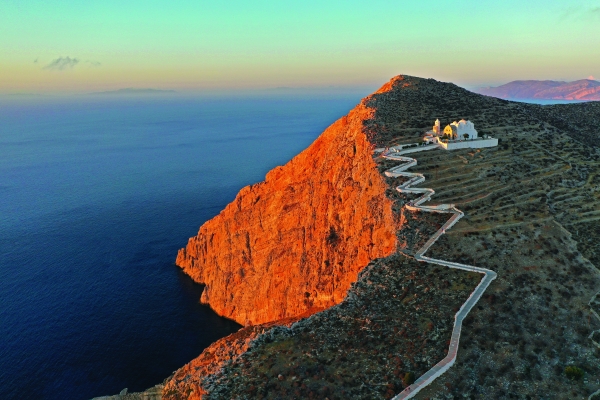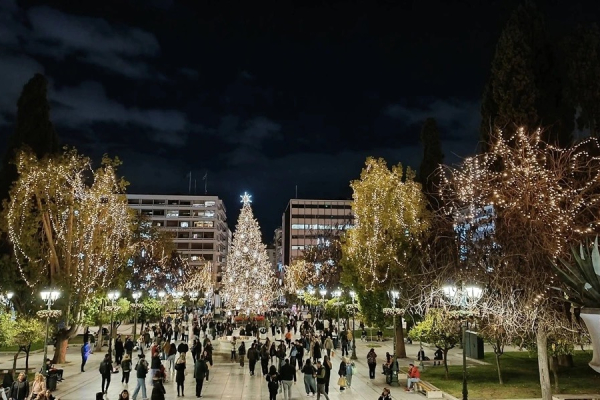By Philippos Kolias
Greece is renowned for its stunning islands, each boasting its own charm and character. While Santorini and Mykonos may steal the spotlight, there are countless islands waiting to be discovered by intrepid travelers seeking the authentic Greek experience. From secluded beaches to traditional villages and unspoiled landscapes, here are some hidden gems of the Greek islands that promise to enchant and delight.
Folegandros Tucked between Santorini and Milos, Folegandros is a serene island paradise that has managed to retain its authentic Greek charm. With its picturesque main village, Chora, perched atop a cliff overlooking the Aegean Sea, and pristine beaches such as Agkali and Livadaki, Folegandros offers a tranquil escape from the crowds.
Amorgos Known for its rugged beauty and spiritual ambiance, Amorgos is a hidden gem in the Cyclades archipelago. Explore its labyrinthine alleys, visit the stunning Monastery of Panagia Hozoviotissa clinging to the cliffs, and unwind on secluded beaches like Agia Anna and Mouros, where crystal-clear waters beckon weary travelers to relax and rejuvenate.
Astypalaia Dubbed the “Butterfly of the Aegean” due to its unique shape, Astypalaia is a lesser-known island that captivates visitors with its unspoiled beauty and traditional charm. Explore its whitewashed villages, discover hidden coves and pristine beaches, and marvel at the imposing Venetian castle that overlooks the island—a testament to its rich history and heritage.
Ikaria Named after the mythical Icarus who fell into the sea nearby, Ikaria is a tranquil haven where time seems to stand still. Known for its laid-back lifestyle, pristine nature, and longevity-promoting diet, Ikaria offers a glimpse into the simple pleasures of Greek island living. Explore its rugged coastline, soak in natural hot springs, and immerse yourself in the local culture at traditional festivals and tavernas.
Symi Nestled near the coast of Turkey, Symi is a gem of the Dodecanese known for its colorful neoclassical architecture and tranquil atmosphere. Wander through its charming harbor town, Symi Town, with its pastel-hued houses and vibrant bougainvillea, and explore hidden gems like the Panormitis Monastery and secluded beaches like Nanou and Marathounda.
Kythira Located off the southern coast of the Peloponnese, Kythira is a lesser-known island steeped in myth and legend. Explore its enchanting villages, visit the medieval castle of Chora, and discover hidden gems like the waterfalls of Fonissa and the stunning beaches of Kaladi and Fyri Ammos, where emerald waters meet golden sands in secluded coves.
Tilos With its pristine landscapes, rich biodiversity, and welcoming atmosphere, Tilos is a hidden paradise in the Dodecanese waiting to be explored. Explore its medieval castles, hike through lush valleys and rugged mountains, and relax on deserted beaches like Agios Antonios and Plaka, where you can enjoy the serenity of island life away from the crowds.
Chios Known as the “Mastic Island” due to its unique cultivation of mastic trees, Chios is a hidden gem in the northeastern Aegean with a wealth of natural beauty and cultural heritage. Explore its medieval villages, visit the UNESCO-listed Mastichochoria, and discover hidden treasures like the Nea Moni monastery and the picturesque beaches of Mavra Volia and Emporios.
Antiparos Antiparos is a small and charming island located in the heart of the Cyclades, just a short ferry ride away from its more famous neighbor, Paros. Despite its proximity to Paros, Antiparos maintains a laid-back and tranquil atmosphere, making it an ideal destination for travelers seeking relaxation and authentic Greek island life. The island's interior is dotted with traditional villages, olive groves and vineyards, providing visitors with plenty of opportunities for exploration and discovery. The famous Antiparos Cave, a natural wonder with striking stalactites and stalagmites, is a must-see for the daring.
Donoussa Ten miles north of Amorgos and east of Naxos, on the southeast coast of the Cyclades archipelago, sits the small island of Donoussa, with only 163 residents. The island is made up of cliffs, hills, and mountains and is only 13.75 km in size. The main village of Donoussa, Stavros, has a small harbor from which ferries to Naxos and Amorgos depart. There is a single ferry on the island that transports guests to each of the sandy beaches with pristine waters.
Schinoussa In the middle of the Small East Cyclades archipelago is Schinoussa. It is a location that genuinely provides peaceful and restful vacations. Belonging to the municipality of Naxos, the journey to the island by ferry from Piraeus takes eight hours. Because of its narrow outlet, Mersini's port is one of the best harbors for small ferries in the entire Aegean Sea.
Keros Named Kereia or Keria in the ancient times, this tiny island northwest of Amorgos is of particular interest to archeology buffs. Keros was first mentioned in an inscription in 425 B.C. that listed the taxpayers of city-states that were allies of Athens. Particularly mountainous, its richness in antiquity came from having one of the most valuable stones in the world - white marble.
Elafonissos Situated on the southeasterly portion of the Peloponnesian peninsula, the island and its adjacent waters harbor a multitude of archaelogical relics that merit exploration. It is thought that the ancient underwater city of Pavlpetri, which dates to the early third century BC, was washed away by the sea at some point around 1000 BC. Another interesting place to visit is Elafonisos’ main church, Agios Spyridon. This church is spread across a narrow, discrete piece of land connected by a bridge that crosses a turquoise sea.
Tiny and untouched
Unspoiled landscapes, spotless shorelines and undiscovered splendor can be found on the small Aegean islands that manage to withstand unbridled tourism growth while preserving their original essence
Polyaigos
Unknown to most, the island of Polyaigos is a favorite among those who appreciate the splendors of Kimolos and Milos. The admiring gaze is drawn even before you approach it to the white vertical cliffs rising imposingly above a sea that resembles an azure oasis within the blue of the Aegean's deeper waters. Τhe coasts unfold a strange yet charming formation of rocks creating also enchanting sea caves, with the most famous among them being the cave of Fanara on the northern side of the island. Fanara's size allows boats to sail through, so it has been captured innumerable times in visitor photos. Diamantospilia, with its tiny quartz crystals glistening on its rocks, is another sight to behold further north. Pano Mersini (also called Myrsini), which faces the islet of Manolonisi, is the most well-liked beach on Polyaigos because of its proximity to Kimolos. Many private boats and yachts make it a popular summer destination due to its white sand and tranquil, turquoise waters that are typically shielded from the strong Aegean winds. Kato Mersini is a stretch of (also) white sand with an amazing sea located a little further south. Hikers can follow a path from Pano Myrsini to the Panagia T' Avlaki beach.
Sikinos
The island is perfect for hiking because of its small size. You will pass through fascinating caves, distinctive beaches, Byzantine chapels, ruins of ancient settlements, and stunning scenery that is protected by the Natura 2000 program. Start at the Monastery of Zoodochos Pigi and travel for approximately two hours to reach Malta Beach or take the ancient cobblestone path from Kastro to Alopronia. The ideal location to witness a breathtaking sunset is at Panagia Pantochara, a tiny chapel that Odysseas Elytis erected on the route from Kastro to the Monastery of Chrysopigi. The ancient city's ruins can also be found atop Agia Marina's hill. Sikinos is an incredibly friendly island with a vibrant cultural scene and friendly locals. They host top-notch festivals, keep the island's trails easily accessible to tourists, and plan the annual “Documentary Days” film festival in the island's open spaces each summer. For the record, free wireless broadband internet access is provided by the municipality to both locals and guests.
Halki
One of Greece's most graceful little islands, Halki is a great place for people looking for a different kind of summer -a summer of complete peace and relaxation in an environment full of glistening seas, untamed scenery, enchanted mountain paths, mouthwatering cuisine- all of which you can explore “on foot”. There is only one settlement on the island (this is how small Halki is), the well-known Nimborio, also known as Emporio by the locals, which is located directly across from the port. A charming village with brightly colored homes and distinctive Dodecanese architecture, as well as lovely balconies with flower pots in bloom and winding cobblestone lanes that stretch out until they meet the azure waters of the Aegean.
While in Halki, spend some time swimming in the sea around the stunning Alimia, the little island sandwiched between Halki and Rhodes. To enjoy swimming in glistening waters and lounging on the expansive, sandy beach of the island, you can rent a boat from Nimborio. Because the island is deserted and there are no supplies to be found, try to pack at least one umbrella and some water or coffee. A small saltwater lake, one of the 37 natural wetlands in the Dodecanese, can be found on the northwest edge of the island's former settlement, which has been abandoned since the 1940s, if you feel like taking a stroll.
Telendos
Known historically as Kelaris, the island of Telendos was formerly connected to Kalymnos until a powerful earthquake in the 6th century AD submerged the land between (to create another amazing Greek island for summertime getaways!) A boat departing from Myrties in Kalymnos regularly connects the two islands; the trip takes about eight minutes. The island is notable for its charming town with old-fashioned taverns, ancient ruins, historical monuments and…happy, lethargic cats. Stroll the trails, climb the stunning vertical cliffs, and take in the Aegean view while in the pine forest. Since cars are not permitted on Telendos, you must travel by private boat or follow the paths to explore the island's beaches. We recommend staying on the beach for the entire day to take in the crimson sunset.
Tilos
It is regarded as one of the Dodecanese's most genuine and environmentally friendly travel destinations. Nestled between Rhodes and Kos, Tilos is one of the smaller islands in the Dodecanese chain. Together with four hundred different kinds of flowers and herbs, the island's tall mountain masses, fertile coastal plains, rocky coasts, and expansive sandy beaches create a natural habitat for many endangered bird species, including the Bonelli's Eagle, Eleonora's Falcon, Long-legged Buzzard, European Shag, Bee-eater, and Heron. It is a sizable ecological park that is safeguarded by international treaties and the first energy-green island in the Mediterranean. The dwarf elephants, the last remaining elephants in Europe, resided here. These days, it's a serene island with charming towns and enchanted beaches, perfect for leisurely getaways. The island's capital, Megalo Chorio, is notable for its stone-built homes' straightforward island architecture, which lends charm to relaxed pace strolls along its winding streets. The Knights of St. John erected a mediaeval castle atop the hill on the location of the island's historic acropolis. Megalo Chorio is home to an Archaeological Museum featuring paleontological finds from the Charkadio Cave, along with other educational materials about the excavations at the cave, as well as a small archaeological collection of vases, inscriptions, sculptures, and more from various parts of the island. Combine your visit to the Museum with a stop at the Charkadio Cave (2 km SE) to see the remains of deer and dwarf elephants that lived 45,000-4,000 years ago, as well as Neolithic ceramics and stone tools.












